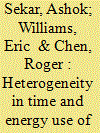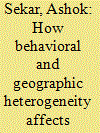|
|
|
Sort Order |
|
|
|
Items / Page
|
|
|
|
|
|
|
| Srl | Item |
| 1 |
ID:
150900


|
|
|
|
|
| Summary/Abstract |
There is substantial variability in residential energy use, partly driven by heterogeneous behavioral patterns. Time-use is relevant to energy when consumption tracks the time a device is used. Cluster analysis is a promising approach to identify time-use patterns. If clusters with particularly long time use and thus high energy consumption emerge, these groups could merit targeted policy intervention. We investigate these ideas via an empirical study of time use for television watching in the U.S. Three clusters were identified. In 2013, the average time spent watching television by Clusters 1, 2 and 3 are dramatically different: 1.1, 3.5 and 7.7 h per day respectively. While members of Cluster 3 are only 14% of the total population they represent 34% of TV energy consumption. The population of Cluster 3 tends to be older, less employed and less educated. Energy savings per adopter is much larger for Cluster 3, suggesting much higher benefits from efficient devices. These results are relevant to the design of efficiency programs, indicating potential for variable rebates and/or tiered communication. With variable rebates, utilities would offer higher incentives to high-use customers. In tiered communication, utilities would devote more resources to engage customers with larger savings potential.
|
|
|
|
|
|
|
|
|
|
|
|
|
|
|
|
| 2 |
ID:
162928


|
|
|
|
|
| Summary/Abstract |
The economic and environmental benefits of efficiency are typically assessed assuming that all consumers use appliances in the same way. There are, however, significant differences in consumer usage patterns, as well as geographical variability in prices and environmental impacts of electricity. To explore the importance of heterogeneity, we first develop distributions of consumer-by-consumer economic benefits from purchasing an efficient versus standard appliance for televisions, clothes washers, and dryers in the U.S. We find large variability, e.g. for washers and dryers, 9% and 7.5% of the U.S. population do not save money over the lifetime of an efficient device, while 11% and 17% save more than twice that of an average consumer. Providing personalized savings information can thus inform and better motivate those consumers who would save more. Abatement costs for carbon and electricity use are similarly heterogenous as consumer economic benefits, indicating that adoption by heavy users is in the public as well as private interest. The cost of abating carbon via a utility appliance rebate program varies greatly by consumer. To scope the emission benefits of targeted adoption, we find that adoption by heavy users saves around 3 times more carbon than an average user for 10% participation in an efficiency program.
|
|
|
|
|
|
|
|
|
|
|
|
|
|
|
|
|
|
|
|
|